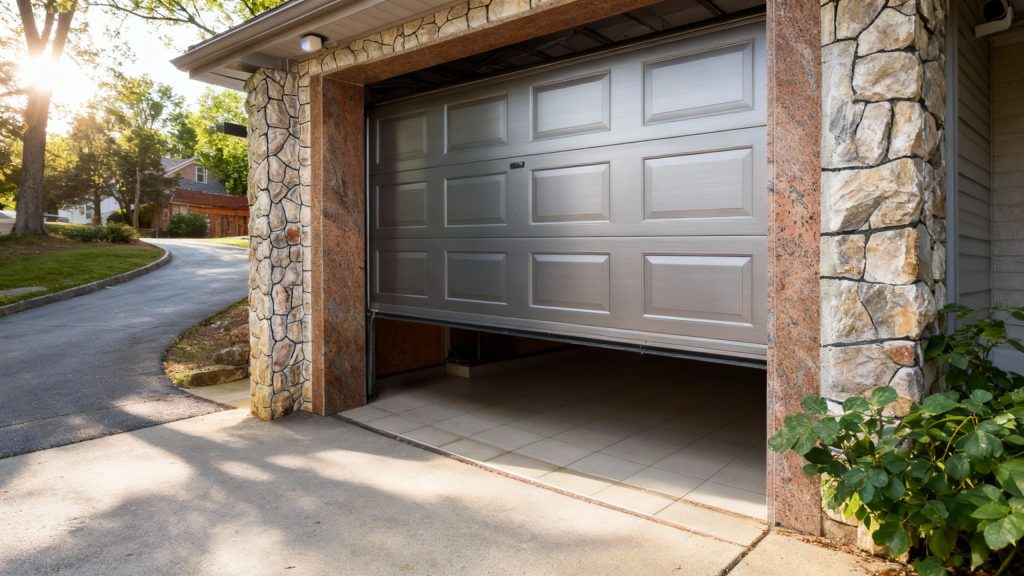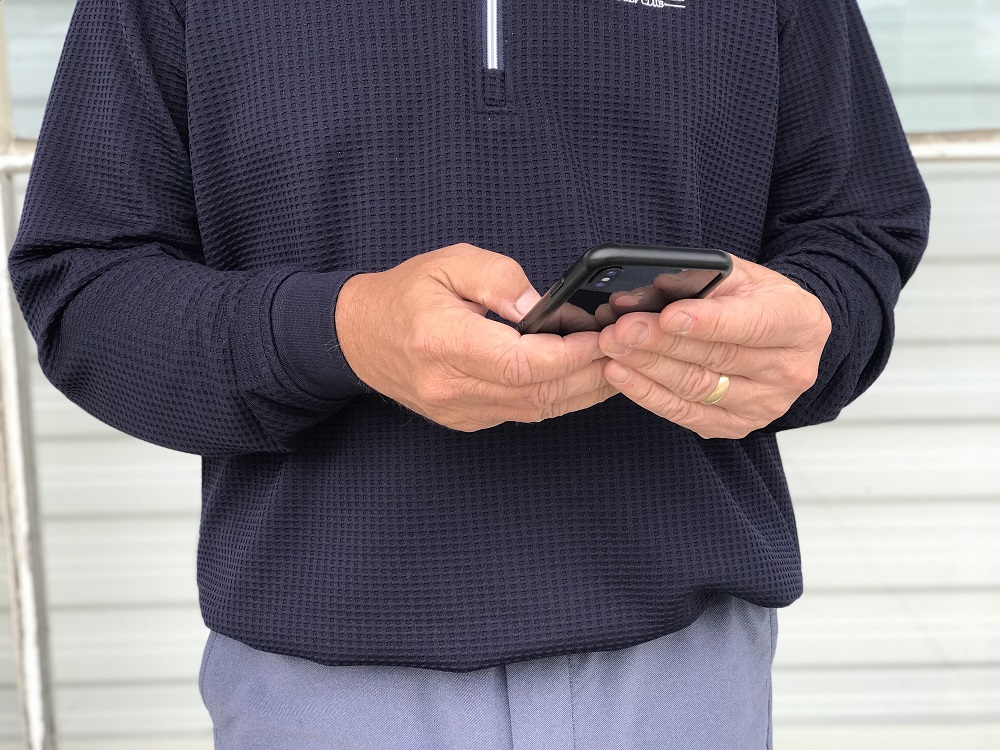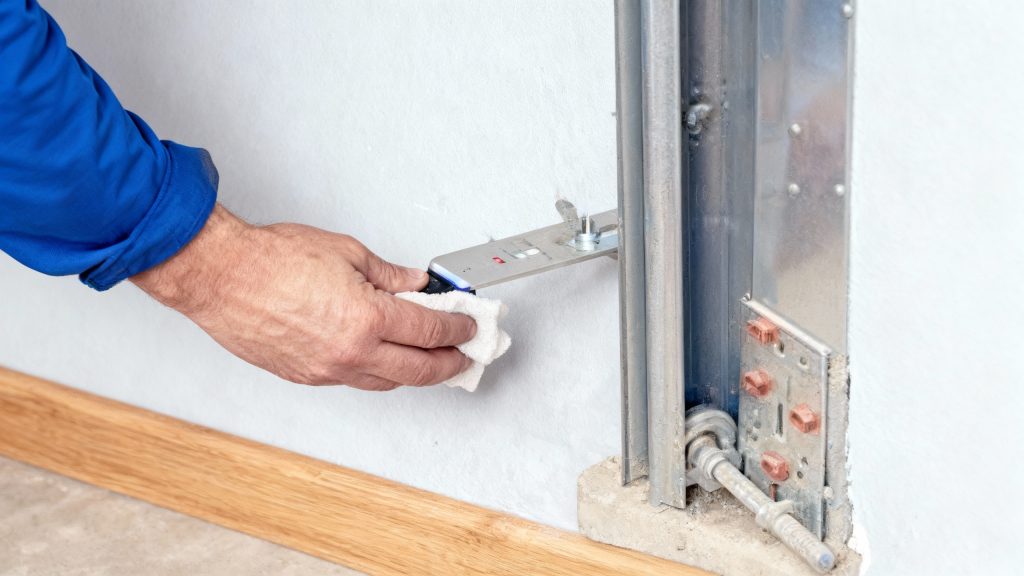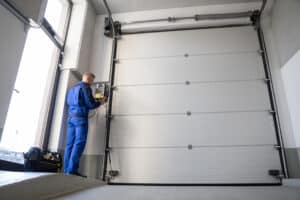Why Would a Garage Door Reverse Before Closing in Homes Around Greenwood?
If your garage door starts to close, hesitates, and then rises again, that’s the opener’s safety system responding to something it detects as an obstruction. While it can be inconvenient, that quick reversal is designed to prevent injury or damage to people, pets, or vehicles.
Common reasons include misaligned or dusty photo eyes, small objects near the threshold, or extra friction in the tracks or rollers that interrupts smooth movement.
At Select Garage Doors, we help Greenwood homeowners pinpoint the cause and restore reliable operation. Contact us now to schedule a safety inspection today and keep your garage door running properly.
Table of Contents
Key Takeaways
- A reversing garage door is usually a safety response, not a malfunction. Modern openers stop and lift when they detect an obstruction or added resistance.
- The most common causes are misaligned photo-eyes, debris on the threshold, sunlight interference, or friction in the hardware.
- Homeowners can safely handle simple checks such as cleaning lenses, clearing paths, and aligning sensors.
- If the problem continues after these steps, deeper issues may be linked to worn parts, travel settings, or balance problems that require professional attention.
- Local Greenwood factors such as afternoon sunlight, frozen thresholds, and dust buildup can also affect sensor accuracy.
- Regular cleaning, lubrication, and balance testing help prevent reversals and keep the door system in top condition.
- When troubleshooting does not resolve the issue, Select Garage Doors can inspect the entire system, make dependable repairs, and verify safety performance before leaving.
How Modern Openers Decide to Reverse
 Residential openers rely on two main safeguards. The first is a pair of photo-eyes near the floor that watch for anything in the path. The second monitors how far the door travels and how much resistance it feels as it closes.
Residential openers rely on two main safeguards. The first is a pair of photo-eyes near the floor that watch for anything in the path. The second monitors how far the door travels and how much resistance it feels as it closes.
If the beam is blocked, the eyes are misaligned, or the opener senses more resistance than expected, it stops and reverses. That logic is normal and intentionally defaults to safety.
Quick Checks You Can Do Safely
These steps require no special tools and often fix the problem.
Clear the Path at Floor Level
Small items near the threshold can fool the system. Look for leaves, ice, toys, shallow boxes, or gravel. Even a thin stick under the bottom seal can trigger a stop.
Clean the Photo-Eyes
Photo-eyes sit about six inches off the floor. Wipe each lens gently with a soft microfiber cloth. Avoid harsh cleaners. If one sensor’s LED is solid and the other is blinking, they are not communicating properly yet.
Align the Sensors
Stand in front of one sensor and point it directly toward the other. Tiny movements matter. Tighten the wingnut by hand. When both LEDs show a steady light, alignment is usually correct.
Check for Sunlight and Reflections
Strong sun or bright reflections can overwhelm the beam, especially in late afternoon or on shiny floors. Shade the sensor with your hand and try again. If shading helps, a small sun shield or a slight bracket adjustment may solve it.
Look for a Manual Lock
Some doors have a slide lock on the handle. If it’s engaged, the opener will meet resistance and reverse. Make sure the lock bar is fully retracted before operating the door.
Inspect Tracks and Rollers for Debris
Do not loosen any hardware. Just look for dirt, hardened grease, or a small screw in the track. Clean light debris with a dry cloth. If you see bent track or rollers that appear flat-spotted, stop here and call a professional.
When Settings or Wear Cause Reversal
If your path is clear and the sensors look fine, the issue might come from the opener’s settings or general wear on the hardware.
Down Travel Set Too Short
Openers stop when they think the door has reached the floor. If the down travel is set too short, the opener stops early, assumes it hit an object, and reverses. Adjusting travel limits can fix this. Follow your opener’s manual closely or call a technician if you’re unsure.
Downforce Set Too Low for Current Conditions
Cold weather can stiffen seals and thicken lubricants, adding light resistance. If downforce is set too low, the door may reverse before closing fully. Only make small adjustments within manufacturer guidance. Avoid masking a binding issue by simply raising the force setting — it’s safer to find and correct the cause of drag.
Hardware Binding That Mimics an Obstacle
Worn rollers, dry hinges, or slightly bent tracks can make the door move unevenly. The opener senses this as an obstruction and reverses. Lightly lubricate hinges and rollers with a garage-door-rated product. If the door still jerks or sticks, schedule a service appointment.
Stop and Call a Professional for These Items

Some problems are not safe for DIY work.
Springs Out of Balance or Damaged
A properly balanced garage door should stay partly open when disconnected from the opener. If it slams shut or flies upward, the spring tension is off. Springs are under extreme pressure and can cause injury. Leave adjustments or replacement to a trained technician.
Frayed Cables or Off-Spool Cables
Lift cables run along the sides and wrap around drums. If you see fraying, broken strands, or a cable off its drum, stop operating the door and call for service immediately.
Opener Wiring or Logic Issues
Loose or damaged low-voltage sensor wires and faulty circuit boards can cause random reversals. These require testing and replacement by a qualified technician.
Greenwood Factors That May Trigger Reversals
Local conditions in Greenwood can affect how sensors and door systems perform.
Sun Angle and Bright Snow
Afternoon sunlight or bright winter snow on the driveway can shine directly into west-facing garages and confuse photo-eyes. A small shade over the sensor or a modest bracket angle change can help.
Freeze and Thaw at the Threshold
Meltwater can refreeze overnight and create a thin ridge that the bottom seal hits first. The opener reads that as resistance. Clearing away ice buildup usually resolves the issue.
Pollen and Dust
During spring and summer, dust or pollen can collect on lenses and tracks. A quick wipe keeps the beam clear and movement smooth.
Driveway Slope
On a steep driveway, one sensor may sit slightly higher than the other. Keeping both sensors level and pointed straight across improves communication.
A Simple Prevention Routine

A few small habits can reduce nuisance reversals and extend your system’s lifespan.
- Wipe sensor lenses monthly.
- Keep the threshold area clean and dry.
- Lubricate hinges and rollers twice a year with a garage-door-rated product. Avoid lubricating the tracks.
- Test balance by lifting the door halfway with the opener disconnected. If it will not stay in place, call a technician.
- Replace cracked or stiff bottom seals.
- Watch and listen during full travel. New scraping, banging, or wobbling sounds need attention.
When to Call Select Garage Doors
If you’ve gone through the safe checks and the door still reverses, it’s time for a closer inspection from Select Garage Doors. This includes checking the springs, cables, rollers, track alignment, sensor wiring, and opener settings.
Our technicians work in Greenwood every day, helping homeowners find and resolve problems that basic troubleshooting can’t fix. We confirm the cause, make reliable repairs, and test your safety system before leaving to be sure your door runs properly.
For quick service or helpful advice before scheduling a visit, call us today.
REQUEST A QUOTE

Our Services
Service Areas
Service Areas
WE SERVICE COLORADO SPRINGS, PARKER, LAKEWOOD AND SURROUNDING AREAS

 SCHEDULE A SERVICE
SCHEDULE A SERVICE



